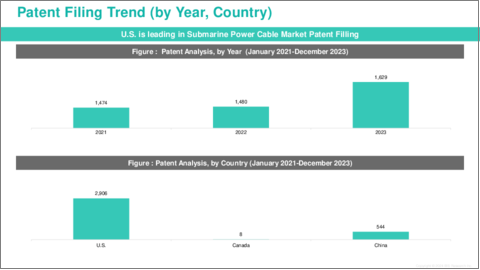|
|
市場調査レポート
商品コード
1566315
海底電力ケーブル市場 - 世界および地域の分析:エンドユーザー・タイプ・コアタイプ・導体材料・電圧・地域別の分析・予測 (2024-2034年)Submarine Power Cable Market - A Global and Regional Analysis: Focus on End-user, Type, Core Type, Conductor Material, Voltage, and Region - Analysis and Forecast, 2024-2034 |
||||||
カスタマイズ可能
|
|||||||
| 海底電力ケーブル市場 - 世界および地域の分析:エンドユーザー・タイプ・コアタイプ・導体材料・電圧・地域別の分析・予測 (2024-2034年) |
|
出版日: 2024年10月09日
発行: BIS Research
ページ情報: 英文 105 Pages
納期: 1~5営業日
|
全表示
- 概要
- 目次
海底電力ケーブル市場は、海を越えた送電のために欠かせないダイナミックな分野です。
海底に敷設され、陸上の発電所と島の間、あるいは大陸を横断するように設計されたこれらのケーブルは、風力発電所のような洋上発電や従来の陸上発電所から需要地への送電を促進します。再生可能エネルギー源に向けた世界の推進力と、信頼性が高く広範な送電ネットワークへのニーズの高まりによって、市場の重要性は高まっています。楽観的な予測では、海底電力ケーブルの市場規模は、2024年の149億8,000万米ドルから、CAGR 10.65%で推移し、2034年には412億米ドルに達すると予測されています。
この市場の大きな促進要因は、洋上風力発電プロジェクトの急成長です。各国が再生可能エネルギー目標の達成と二酸化炭素排出量の削減に努める中、洋上風力発電所は陸上と比べて風速が高く安定しているため、好まれる選択肢となっています。こうしたプロジェクトでは、洋上タービンと陸上の主要送電網を結ぶ海底電力ケーブルが不可欠です。例えば、洋上風力発電容量でリードする欧州などの地域では、送電を最適化するために高度な海底ケーブル技術に大きく依存しています。
| 主要市場統計 | |
|---|---|
| 予測期間 | 2024-2034年 |
| 2024年評価 | 149億8,000万米ドル |
| 2034年予測 | 412億米ドル |
| CAGR | 10.65% |
特に高電圧直流 (HVDC) 技術における技術の進歩が、市場をさらに押し上げています。HVDCケーブルは、長距離を最小限の損失で送電する効率性で好まれており、洋上施設と陸上グリッド接続間の長距離伝送に不可欠な能力です。この技術は、再生可能エネルギープロジェクトだけでなく、大陸間の電力共有もサポートし、エネルギー安全保障と市場統合を強化します。
東南アジアやアフリカなど、エネルギーインフラが発展途上にある新興市場にも、市場機会は豊富にあります。これらの地域には、エネルギー需要が急速に伸びている群島や点在する離島地域があります。堅牢で効率的な接続を提供する海底電力ケーブルの能力は、地域の電化プロジェクトや持続可能な開発目標をサポートし、参入事業者に大きな成長の見通しを提供します。
当レポートでは、世界の海底電力ケーブルの市場を調査し、業界の動向、技術・特許の動向、法規制環境、市場成長促進要因・抑制要因、市場規模の推移・予測、各種区分・主要国別の詳細分析、競合情勢、主要企業のプロファイルなどをまとめています。
目次
エグゼクティブサマリー
第1章 市場:業界の展望
- 動向:現在および将来の影響評価
- サプライチェーンの概要
- バリューチェーン分析
- 価格予測
- R&Dレビュー
- 国・企業別の特許出願動向
- 規制状況
- ステークホルダー分析
- 使用事例
- エンドユーザーと購入基準
- 主要な世界的イベントの影響分析
- 市場力学の概要
- 市場促進要因
- 市場抑制要因
- 市場機会
第2章 海底電力ケーブル市場:用途別
- 用途の分類
- 用途の概要
- 海底電力ケーブル市場:エンドユーザー別
- 洋上風力発電
- 国・離島間の接続
- オフショア石油・ガス
第3章 海底電力ケーブル市場:製品別
- 製品の分類
- 製品概要
- 海底電力ケーブル市場:タイプ別
- 交流
- 直流
- 海底電力ケーブル市場:コアタイプ別
- シングルコア
- マルチコア
- 海底電力ケーブル市場:導体材料別
- 銅
- アルミニウム
- 海底電力ケーブル市場:電圧別
- 中圧
- 高圧
第4章 海底電力ケーブル市場:地域別
- 海底電力ケーブル市場:地域別
- 北米
- 地域概要
- 市場成長推進因子
- 市場課題
- 用途
- 製品
- 米国
- カナダ
- メキシコ
- 欧州
- 地域概要
- 市場成長推進因子
- 市場課題
- 用途
- 製品
- ドイツ
- フランス
- オランダ
- 英国
- イタリア
- その他
- アジア太平洋
- 地域概要
- 市場成長推進因子
- 市場課題
- 用途
- 製品
- 中国
- 日本
- インド
- 韓国
- その他
- その他の地域
- 地域概要
- 市場成長推進因子
- 市場課題
- 用途
- 製品
- 南米
- 中東・アフリカ
第5章 企業プロファイル
- 次なるフロンティア
- 地理的評価
- Prysmian Group
- Nexans SA
- Sumitomo Electric Industries Limited
- NKT A/S
- LS Cable & System Ltd.
- Furukawa Electric Co., Ltd
- ZTT
- KEI Industries Limited
- TFKABLE
- Taihan Cable & Solution Co., Ltd.
- Hengtong Group Co., Ltd
- Tratos
- Hydro Group
- The Okonite Company
- Hellenic Cables
- その他
第6章 調査手法
Introduction to Submarine Power Cable Market
The submarine power cable market is a dynamic sector crucial for the global transmission of electricity across oceans and seas. These cables, designed to be laid on the seabed between land-based stations and islands or across continents, facilitate the essential transfer of electricity from offshore power generation sources like wind farms and traditional onshore power plants to areas of demand. The market's relevance has been heightened by the global push towards renewable energy sources and the increasing need for reliable and extensive energy distribution networks. In an optimistic forecast, the market, valued at $14.98 billion in 2024, is projected to grow at a CAGR of 10.65%, reaching $41.20 billion by 2034.
A significant driver for this market is the rapid growth of offshore wind energy projects. As countries strive to meet their renewable energy targets and reduce carbon emissions, offshore wind farms have become a favoured choice due to their higher and more consistent wind speeds compared to onshore sites. Submarine power cables are indispensable in these projects, connecting the offshore turbines to the main power grid on land. For instance, regions such as Europe, which leads in offshore wind capacity, heavily depend on advanced submarine cable technologies to optimize energy transmission.
| KEY MARKET STATISTICS | |
|---|---|
| Forecast Period | 2024 - 2034 |
| 2024 Evaluation | $14.98 Billion |
| 2034 Forecast | $41.20 Billion |
| CAGR | 10.65% |
Technological advancements, particularly in High Voltage Direct Current (HVDC) technology, have further propelled the market. HVDC cables are preferred for their efficiency in transmitting electricity over long distances with minimal losses, a capability crucial for the long stretches between offshore installations and shore-based grid connections. This technology supports not just renewable energy projects but also intercontinental power sharing, enhancing energy security and market integration.
Market opportunities also abound in emerging regions where energy infrastructure is still developing, such as Southeast Asia and Africa. These regions are characterized by archipelagos and scattered island communities where energy demand is growing rapidly. The ability of submarine power cables to provide robust and efficient connections supports regional electrification projects and sustainable development goals, offering substantial growth prospects for market players.
As the world intensifies its commitment to renewable energy and seeks more robust, interconnected power networks, the Submarine Power Cable Market is poised to play a pivotal role in shaping global energy landscapes. Through technological advancements and strategic market expansions, it is set to address the growing demand for reliable and efficient energy transmission, particularly in offshore and inter-regional applications.
Market Segmentation
Segmentation 1: by End-user
- Offshore Wind Power Generation
- Inter-country and Island Connection
- Offshore Oil and Gas
Segmentation 2: by Type
- AC
- DC
Segmentation 3: by Core Type
- Single Core
- Multicore
Segmentation 4: by Conductor Material
- Copper
- Aluminium
Segmentation 5: by Voltage
- Medium
- High
Segmentation 6: by Region
- North America
- Europe
- Asia-Pacific
- Rest-of-the-World
How can this Report add value to an Organization?
Product / Innovation Strategy: The global submarine power cable market has been extensively segmented based on various categories such as end-user, type, core type, conductor material, and voltage. This can help readers get a clear overview of which segments account for the largest share and which ones are well-positioned to grow in the coming years.
Competitive Strategy: A detailed competitive benchmarking of the players operating in the global submarine power cable market has been done to help the reader understand how players stack against each other, presenting a clear market landscape. Additionally, comprehensive competitive strategies such as partnerships, agreements, and collaborations will aid the reader in understanding the untapped revenue pockets in the market.
Key Market Players and Competition Synopsis
The companies that are profiled have been selected based on thorough secondary research, which includes analyzing company coverage, product portfolio, market penetration, and insights gathered from primary experts.
Some of the prominent companies in this market are:
- Prysmian Group
- Sumitomo Electric Industries Limited
- LS Cable & System Ltd.
- NKT A/S
- Nexans SA
Key Questions Answered in this Report:
- What are the main factors driving the demand for global submarine power cable market?
- What are the major patents filed by the companies active in submarine power cable market?
- Who are the key players in the submarine power cable market, and what are their respective market shares?
- What are the strategies adopted by the key companies to gain a competitive edge in global submarine power cable market?
- What is the futuristic outlook for the submarine power cable market in terms of growth potential?
- What is the current estimation of the global submarine power cable market, and what growth trajectory is projected from 2024 to 2034?
- Which application, and product segment is expected to lead the market over the forecast period (2024-2034)?
- Which regions demonstrate the highest adoption rates for global submarine power cable market, and what factors contribute to their leadership?
Table of Contents
Executive Summary
Scope and Definition
Market/Product Definition
Key Questions Answered
Analysis and Forecast Note
1. Markets: Industry Outlook
- 1.1 Trends: Current and Future Impact Assessment
- 1.2 Supply Chain Overview
- 1.2.1 Value Chain Analysis
- 1.2.2 Pricing Forecast
- 1.3 R&D Review
- 1.3.1 Patent Filing Trend by Country, by Company
- 1.4 Regulatory Landscape
- 1.5 Stakeholder Analysis
- 1.5.1 Use Case
- 1.5.2 End User and Buying Criteria
- 1.6 Impact Analysis for Key Global Events
- 1.7 Market Dynamics Overview
- 1.7.1 Market Drivers
- 1.7.2 Market Restraints
- 1.7.3 Market Opportunities
2. Submarine Power Cable Market (by Application)
- 2.1 Application Segmentation
- 2.2 Application Summary
- 2.3 Submarine Power Cable Market (by End-user)
- 2.3.1 Offshore Wind Power Generation
- 2.3.2 Inter-country and Island Connection
- 2.3.3 Offshore Oil and Gas
3. Submarine Power Cable Market (by Product)
- 3.1 Product Segmentation
- 3.2 Product Summary
- 3.3 Submarine Power Cable Market (by Type)
- 3.3.1 AC
- 3.3.2 DC
- 3.4 Submarine Power Cable Market (by Core Type)
- 3.4.1 Single Core
- 3.4.2 Multicore
- 3.5 Submarine Power Cable Market (by Conductor Material)
- 3.5.1 Copper
- 3.5.2 Aluminium
- 3.6 Submarine Power Cable Market (by Voltage)
- 3.6.1 Medium
- 3.6.2 High
4. Submarine Power Cable Market (by Region)
- 4.1 Submarine Power Cable Market (by Region)
- 4.2 North America
- 4.2.1 Regional Overview
- 4.2.2 Driving Factors for Market Growth
- 4.2.3 Factors Challenging the Market
- 4.2.4 Application
- 4.2.5 Product
- 4.2.6 U.S.
- 4.2.6.1 Market by Application
- 4.2.6.2 Market by Product
- 4.2.7 Canada
- 4.2.7.1 Market by Application
- 4.2.7.2 Market by Product
- 4.2.8 Mexico
- 4.2.8.1 Market by Application
- 4.2.8.2 Market by Product
- 4.3 Europe
- 4.3.1 Regional Overview
- 4.3.2 Driving Factors for Market Growth
- 4.3.3 Factors Challenging the Market
- 4.3.4 Application
- 4.3.5 Product
- 4.3.6 Germany
- 4.3.6.1 Market by Application
- 4.3.6.2 Market by Product
- 4.3.7 France
- 4.3.7.1 Market by Application
- 4.3.7.2 Market by Product
- 4.3.8 Netherlands
- 4.3.8.1 Market by Application
- 4.3.8.2 Market by Product
- 4.3.9 U.K.
- 4.3.9.1 Market by Application
- 4.3.9.2 Market by Product
- 4.3.10 Italy
- 4.3.10.1 Market by Application
- 4.3.10.2 Market by Product
- 4.3.11 Rest-of-Europe
- 4.3.11.1 Market by Application
- 4.3.11.2 Market by Product
- 4.4 Asia-Pacific
- 4.4.1 Regional Overview
- 4.4.2 Driving Factors for Market Growth
- 4.4.3 Factors Challenging the Market
- 4.4.4 Application
- 4.4.5 Product
- 4.4.6 China
- 4.4.6.1 Market by Application
- 4.4.6.2 Market by Product
- 4.4.7 Japan
- 4.4.7.1 Market by Application
- 4.4.7.2 Market by Product
- 4.4.8 India
- 4.4.8.1 Market by Application
- 4.4.8.2 Market by Product
- 4.4.9 South Korea
- 4.4.9.1 Market by Application
- 4.4.9.2 Market by Product
- 4.4.10 Rest-of-Asia-Pacific
- 4.4.10.1 Market by Application
- 4.4.10.2 Market by Product
- 4.5 Rest-of-the-World
- 4.5.1 Regional Overview
- 4.5.2 Driving Factors for Market Growth
- 4.5.3 Factors Challenging the Market
- 4.5.4 Application
- 4.5.5 Product
- 4.5.6 South America
- 4.5.6.1 Market by Application
- 4.5.6.2 Market by Product
- 4.5.7 Middle East and Africa
- 4.5.7.1 Market by Application
- 4.5.7.2 Market by Product
5. Companies Profiled
- 5.1 Next Frontiers
- 5.2 Geographic Assessment
- 5.2.1 Prysmian Group
- 5.2.1.1 Overview
- 5.2.1.2 Top Products/Product Portfolio
- 5.2.1.3 Top Competitors
- 5.2.1.4 Target Customers
- 5.2.1.5 Key Personnel
- 5.2.1.6 Analyst View
- 5.2.1.7 Market Share
- 5.2.2 Nexans SA
- 5.2.2.1 Overview
- 5.2.2.2 Top Products/Product Portfolio
- 5.2.2.3 Top Competitors
- 5.2.2.4 Target Customers
- 5.2.2.5 Key Personnel
- 5.2.2.6 Analyst View
- 5.2.2.7 Market Share
- 5.2.3 Sumitomo Electric Industries Limited
- 5.2.3.1 Overview
- 5.2.3.2 Top Products/Product Portfolio
- 5.2.3.3 Top Competitors
- 5.2.3.4 Target Customers
- 5.2.3.5 Key Personnel
- 5.2.3.6 Analyst View
- 5.2.3.7 Market Share
- 5.2.4 NKT A/S
- 5.2.4.1 Overview
- 5.2.4.2 Top Products/Product Portfolio
- 5.2.4.3 Top Competitors
- 5.2.4.4 Target Customers
- 5.2.4.5 Key Personnel
- 5.2.4.6 Analyst View
- 5.2.4.7 Market Share
- 5.2.5 LS Cable & System Ltd.
- 5.2.5.1 Overview
- 5.2.5.2 Top Products/Product Portfolio
- 5.2.5.3 Top Competitors
- 5.2.5.4 Target Customers
- 5.2.5.5 Key Personnel
- 5.2.5.6 Analyst View
- 5.2.5.7 Market Share
- 5.2.6 Furukawa Electric Co., Ltd
- 5.2.6.1 Overview
- 5.2.6.2 Top Products/Product Portfolio
- 5.2.6.3 Top Competitors
- 5.2.6.4 Target Customers
- 5.2.6.5 Key Personnel
- 5.2.6.6 Analyst View
- 5.2.6.7 Market Share
- 5.2.7 ZTT
- 5.2.7.1 Overview
- 5.2.7.2 Top Products/Product Portfolio
- 5.2.7.3 Top Competitors
- 5.2.7.4 Target Customers
- 5.2.7.5 Key Personnel
- 5.2.7.6 Analyst View
- 5.2.7.7 Market Share
- 5.2.8 KEI Industries Limited
- 5.2.8.1 Overview
- 5.2.8.2 Top Products/Product Portfolio
- 5.2.8.3 Top Competitors
- 5.2.8.4 Target Customers
- 5.2.8.5 Key Personnel
- 5.2.8.6 Analyst View
- 5.2.8.7 Market Share
- 5.2.9 TFKABLE
- 5.2.9.1 Overview
- 5.2.9.2 Top Products/Product Portfolio
- 5.2.9.3 Top Competitors
- 5.2.9.4 Target Customers
- 5.2.9.5 Key Personnel
- 5.2.9.6 Analyst View
- 5.2.9.7 Market Share
- 5.2.10 Taihan Cable & Solution Co., Ltd.
- 5.2.10.1 Overview
- 5.2.10.2 Top Products/Product Portfolio
- 5.2.10.3 Top Competitors
- 5.2.10.4 Target Customers
- 5.2.10.5 Key Personnel
- 5.2.10.6 Analyst View
- 5.2.10.7 Market Share
- 5.2.11 Hengtong Group Co., Ltd
- 5.2.11.1 Overview
- 5.2.11.2 Top Products/Product Portfolio
- 5.2.11.3 Top Competitors
- 5.2.11.4 Target Customers
- 5.2.11.5 Key Personnel
- 5.2.11.6 Analyst View
- 5.2.11.7 Market Share
- 5.2.12 Tratos
- 5.2.12.1 Overview
- 5.2.12.2 Top Products/Product Portfolio
- 5.2.12.3 Top Competitors
- 5.2.12.4 Target Customers
- 5.2.12.5 Key Personnel
- 5.2.12.6 Analyst View
- 5.2.12.7 Market Share
- 5.2.13 Hydro Group
- 5.2.13.1 Overview
- 5.2.13.2 Top Products/Product Portfolio
- 5.2.13.3 Top Competitors
- 5.2.13.4 Target Customers
- 5.2.13.5 Key Personnel
- 5.2.13.6 Analyst View
- 5.2.13.7 Market Share
- 5.2.14 The Okonite Company
- 5.2.14.1 Overview
- 5.2.14.2 Top Products/Product Portfolio
- 5.2.14.3 Top Competitors
- 5.2.14.4 Target Customers
- 5.2.14.5 Key Personnel
- 5.2.14.6 Analyst View
- 5.2.14.7 Market Share
- 5.2.15 Hellenic Cables
- 5.2.15.1 Overview
- 5.2.15.2 Top Products/Product Portfolio
- 5.2.15.3 Top Competitors
- 5.2.15.4 Target Customers
- 5.2.15.5 Key Personnel
- 5.2.15.6 Analyst View
- 5.2.15.7 Market Share
- 5.2.16 Others
- 5.2.1 Prysmian Group





